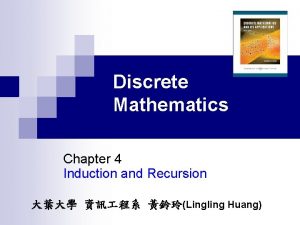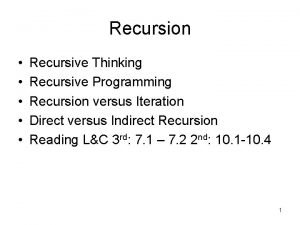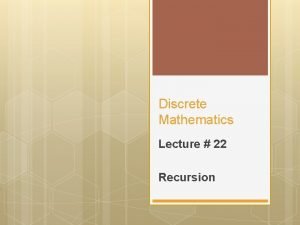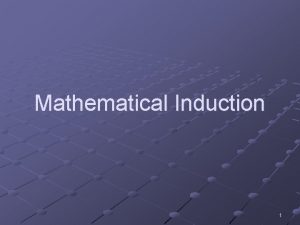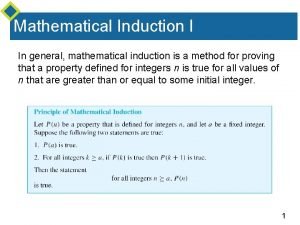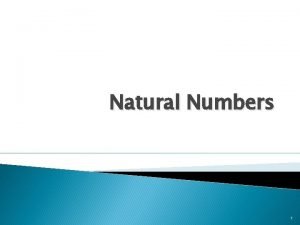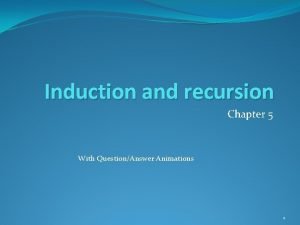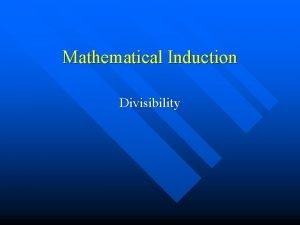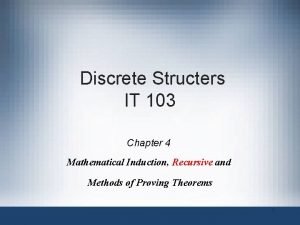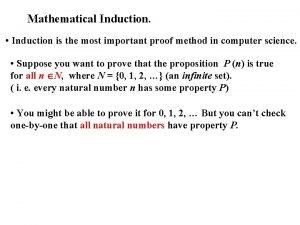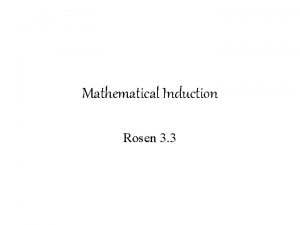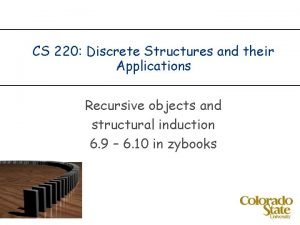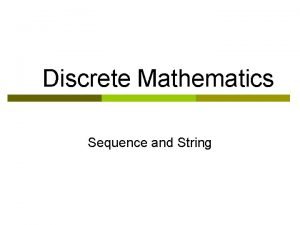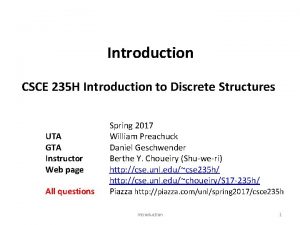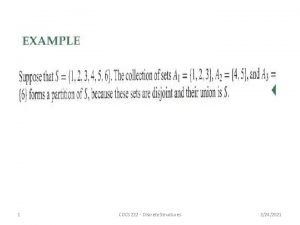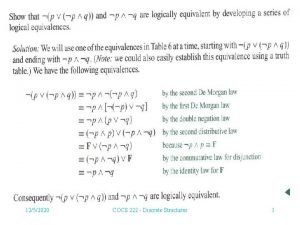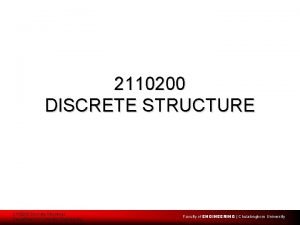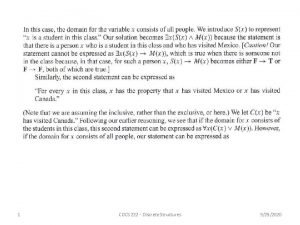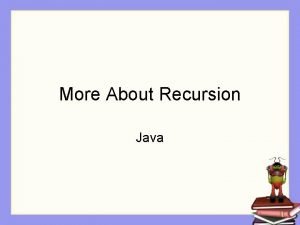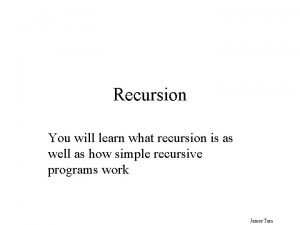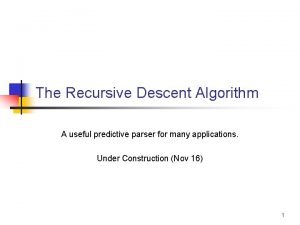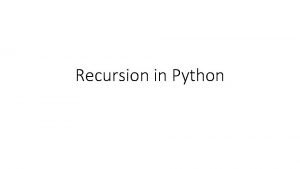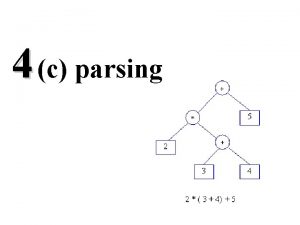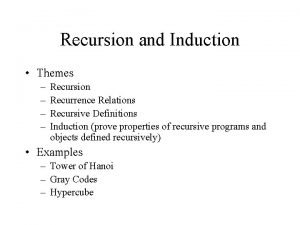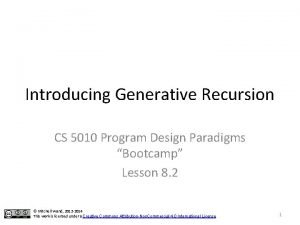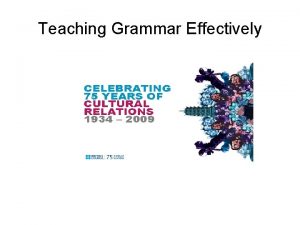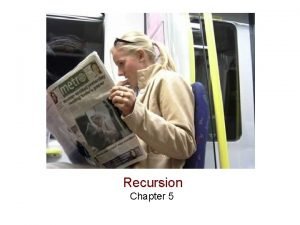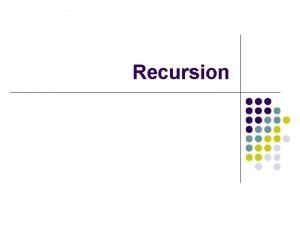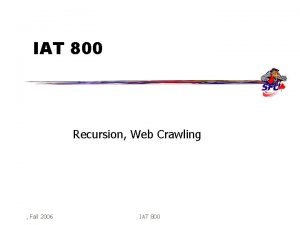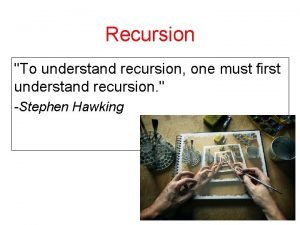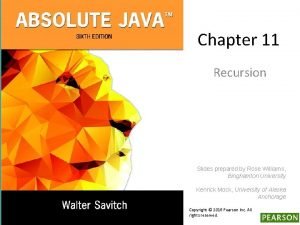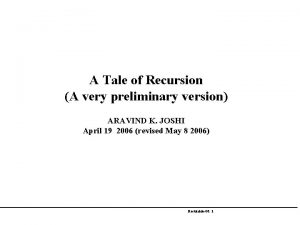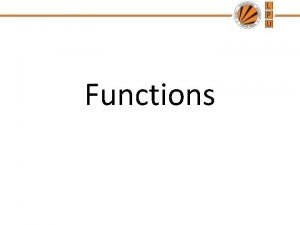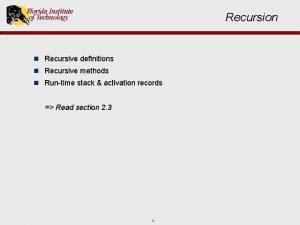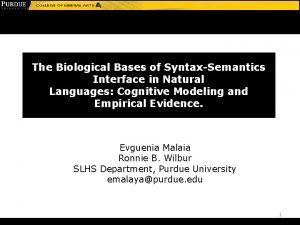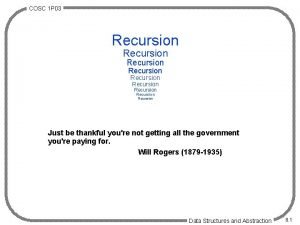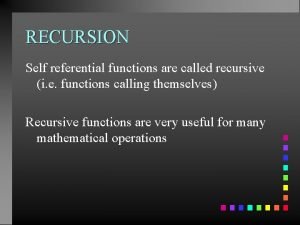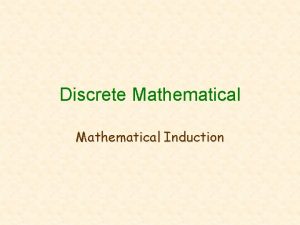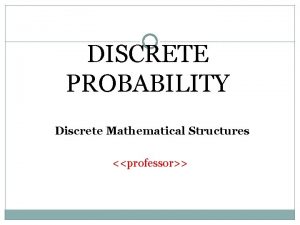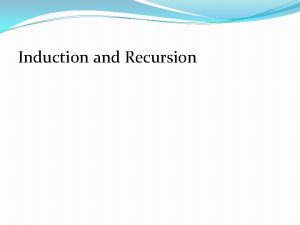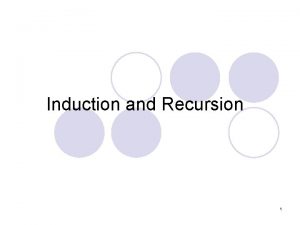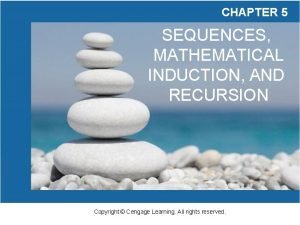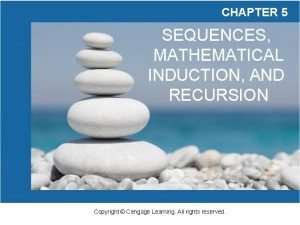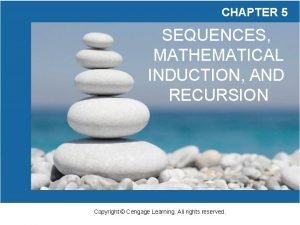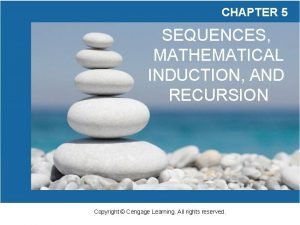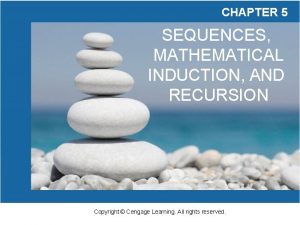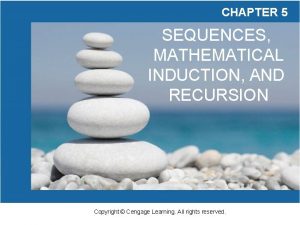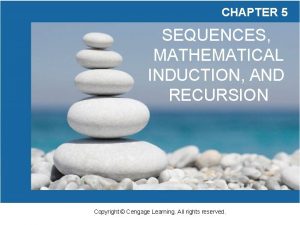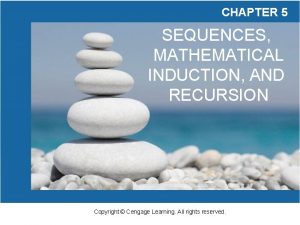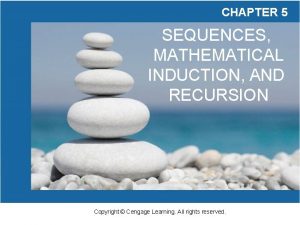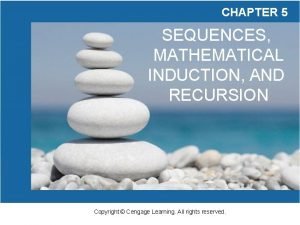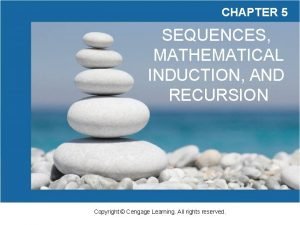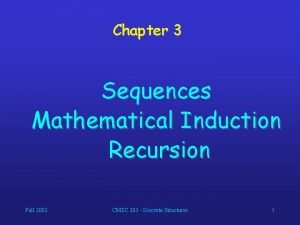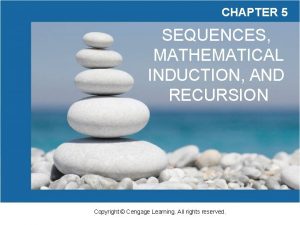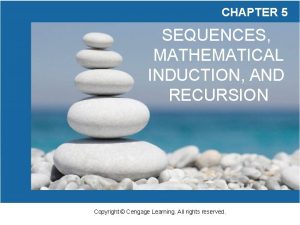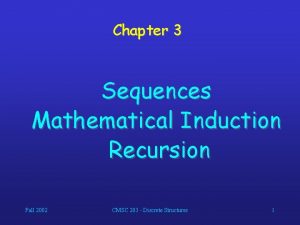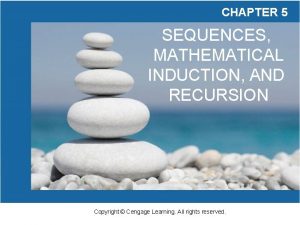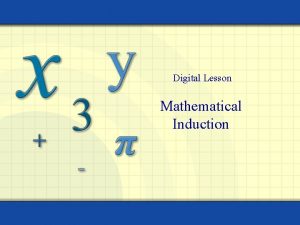Sequences Mathematical Induction Recursion Discrete Structures 1 Sequences













































- Slides: 45

Sequences Mathematical Induction Recursion Discrete Structures 1

Sequences Discrete Structures 2

Sequences represent ordered lists of elements. A sequence is defined as a function from a subset of N to a set S. We use the notation an to denote the image of the integer n. We call an a term of the sequence. Example: subset of N: 1 2 3 4 5 … S: 2 4 6 8 10 … Discrete Structures 3

Sequences We use the notation {an} to describe a sequence. Important: Do not confuse this with the {} used in set notation. It is convenient to describe a sequence with a formula. For example, the sequence on the previous slide can be specified as {an}, where an = 2 n. Discrete Structures 4

The Formula Game What are the formulas that describe the following sequences a 1, a 2, a 3, … ? 1, 3, 5, 7, 9, … an = 2 n – 1 -1, 1, -1, … an = (-1)n 2, 5, 10, 17, 26, … an = n 2 + 1 0. 25, 0. 75, 1, 1. 25 … an = 0. 25 n 3, 9, 27, 81, 243, … an = 3 n Discrete Structures 5

Strings Finite sequences are also called strings, denoted by a 1 a 2 a 3…an. The length of a string S is the number of terms that it consists of. The empty string contains no terms at all. It has length zero. Discrete Structures 6

Summations What does stand for? It represents the sum am + am+1 + am+2 + … + an. The variable j is called the index of summation, running from its lower limit m to its upper limit n. We could as well have used any other letter to denote this index. Discrete Structures 7

Summations How can we express the sum of the first 1000 terms of the sequence {an} with an=n 2 for n = 1, 2, 3, … ? We write it as . What is the value of ? It is 1 + 2 + 3 + 4 + 5 + 6 = 21. What is the value of ? It is so much work to calculate this… Discrete Structures 8

Summations It is said that Friedrich Gauss came up with the following formula: When you have such a formula, the result of any summation can be calculated much more easily, for example: Discrete Structures 9

Arithemetic Series How does: ? ? ? Observe that: 1 + 2 + 3 +…+ n/2 + (n/2 + 1) +…+ (n - 2) + (n - 1) + n = [1 + n] + [2 + (n - 1)] + [3 + (n - 2)] +…+ [n/2 + (n/2 + 1)] = (n + 1) + … + (n + 1) (with n/2 terms) = n(n + 1)/2. Discrete Structures 10

Geometric Series How does: ? ? ? Observe that: S = 1 + a 2 + a 3 + … + a n a. S = a + a 2 + a 3 + … + an + a(n+1) so, (a. S - S) = (a - 1)S = a(n+1) - 1 Therefore, 1 + a 2 + … + an = (a(n+1) - 1) / (a - 1). For example: 1 + 2 + 4 + 8 +… + 1024 = 2047. Discrete Structures 11

Useful Series 1. 2. 3. 4. Discrete Structures 12

Double Summations Corresponding to nested loops in C++ or Java, there is also double (or triple etc. ) summation: Example: Discrete Structures 13

Follow me for a walk through. . . Mathematical Induction Discrete Structures 14

Induction The principle of mathematical induction is a useful tool for proving that a certain predicate is true for all natural numbers. It cannot be used to discover theorems, but only to prove them. Discrete Structures 15

Induction If we have a propositional function P(n), and we want to prove that P(n) is true for any natural number n, we do the following: • Show that P(0) is true. (basis step) • Show that if P(n) then P(n + 1) for any n N. (inductive step) • Then P(n) must be true for any n N. (conclusion) Discrete Structures 16

Induction Example: Show that n < 2 n for all positive integers n. Let P(n) be the proposition “n < 2 n. ” 1. Show that P(1) is true. (basis step) P(1) is true, because 1 < 21 = 2. Discrete Structures 17

Induction 2. Show that if P(n) is true, then P(n + 1) is true. (inductive step) Assume that n < 2 n is true. We need to show that P(n + 1) is true, i. e. n + 1 < 2 n+1 We start from n < 2 n: n + 1 < 2 n + 1 2 n + 2 n = 2 n+1 Therefore, if n < 2 n then n + 1 < 2 n+1 Discrete Structures 18

Induction • Then P(n) must be true for any positive integer. (conclusion) n < 2 n is true for any positive integer. End of proof. Discrete Structures 19

Induction Another Example (“Gauss”): 1 + 2 + … + n = n (n + 1)/2 • Show that P(0) is true. (basis step) For n = 0 we get 0 = 0. True. Discrete Structures 20

Induction • Show that if P(n) then P(n + 1) for any n N. (inductive step) 1 + 2 + … + n = n (n + 1)/2 1 + 2 + … + n + (n + 1) = n (n + 1)/2 + (n + 1) = (2 n + 2 + n (n + 1))/2 = (2 n + 2 + n)/2 = (2 + 3 n + n 2 )/2 = (n + 1) (n + 2)/2 = (n + 1) ((n + 1)/2 Discrete Structures 21

Induction • Then P(n) must be true for any n N. (conclusion) 1 + 2 + … + n = n (n + 1)/2 is true for all n N. End of proof. Discrete Structures 22

Induction There is another proof technique that is very similar to the principle of mathematical induction. It is called the second principle of mathematical induction (AKA strong induction). It can be used to prove that a propositional function P(n) is true for any natural number n. Discrete Structures 23

Induction The second principle of mathematical induction: • Show that P(0) is true. (basis step) • Show that if P(0) and P(1) and … and P(n), then P(n + 1) for any n N. (inductive step) • Then P(n) must be true for any n N. (conclusion) Discrete Structures 24

Induction Example: Show that every integer greater than 1 can be written as the product of primes. • Show that P(2) is true. (basis step) 2 is the product of one prime: itself. Discrete Structures 25

Induction • Show that if P(2) and P(3) and … and P(n), then P(n + 1) for any n N. (inductive step) Two possible cases: • If (n + 1) is prime, then obviously P(n + 1) is true. • If (n + 1) is composite, it can be written as the product of two integers a and b such that 2 a b < n + 1. By the induction hypothesis, both a and b can be written as the product of primes. Therefore, n + 1 = a b can be written as the product of primes. Discrete Structures 26

Induction • Then P(n) must be true for any n N. (conclusion) End of proof. We have shown that every integer greater than 1 can be written as the product of primes. Discrete Structures 27

If I told you once, it must be. . . Recursion Discrete Structures 28

Recursive Definitions Recursion is a principle closely related to mathematical induction. In a recursive definition, an object is defined in terms of itself. We can recursively define sequences, functions and sets. Discrete Structures 29

Recursively Defined Sequences Example: The sequence {an} of powers of 2 is given by an = 2 n for n = 0, 1, 2, …. The same sequence can also be defined recursively: a 0 = 1 an+1 = 2 an for n = 0, 1, 2, … Obviously, induction and recursion are similar principles. Discrete Structures 30

Recursively Defined Functions We can use the following method to define a function with the natural numbers as its domain: • Base case: Specify the value of the function at zero. • Recursion: Give a rule for finding its value at any integer from its values at smaller integers. Such a definition is called recursive or inductive definition. Discrete Structures 31

Recursively Defined Functions Example: f(0) = 3 f(n + 1) = 2 f(n) + 3 f(0) = 3 f(1) = 2 f(0) + 3 = 2 3 + 3 = 9 f(2) = 2 f(1) + 3 = 2 9 + 3 = 21 f(3) = 2 f(2) + 3 = 2 21 + 3 = 45 f(4) = 2 f(3) + 3 = 2 45 + 3 = 93 Discrete Structures 32

Recursively Defined Functions How can we recursively define the factorial function f(n) = n! ? f(0) = 1 f(n + 1) = (n + 1)f(n) f(0) = 1 f(1) = 1 f(0) = 1 1 = 1 f(2) = 2 f(1) = 2 1 = 2 f(3) = 3 f(2) = 3 2 = 6 f(4) = 4 f(3) = 4 6 = 24 Discrete Structures 33

Recursively Defined Functions A famous example: The Fibonacci numbers f(0) = 0, f(1) = 1 f(n) = f(n – 1) + f(n - 2) f(0) = 0 f(1) = 1 f(2) = f(1) + f(0) = 1 + 0 = 1 f(3) = f(2) + f(1) = 1 + 1 = 2 f(4) = f(3) + f(2) = 2 + 1 = 3 f(5) = f(4) + f(3) = 3 + 2 = 5 f(6) = f(5) + f(4) = 5 + 3 = 8 Discrete Structures 34

Recursively Defined Sets If we want to recursively define a set, we need to provide two things: • an initial set of elements, • rules for the construction of additional elements from elements in the set. Example: Let S be recursively defined by: 3 S (x + y) S if (x S) and (y S) S is the set of positive integers divisible by 3. Discrete Structures 35

Recursively Defined Sets Proof: Let A be the set of all positive integers divisible by 3. To show that A = S, we must show that A S and S A. Part I: To prove that A S, we must show that every positive integer divisible by 3 is in S. We will use mathematical induction to show this. Discrete Structures 36

Recursively Defined Sets Let P(n) be the statement “ 3 n belongs to S”. Basis step: P(1) is true, because 3 is in S. Inductive step: To show: If P(n) is true, then P(n + 1) is true. Assume 3 n is in S. Since 3 n is in S and 3 is in S, it follows from the recursive definition of S that 3 n + 3 = 3(n + 1) is also in S. Conclusion of Part I: A S. Discrete Structures 37

Recursively Defined Sets Part II: To show: S A. Basis step: To show: All initial elements of S are in A. 3 is in A. True. Inductive step: To show: If x and y in S are in A, then (x + y) is in A. Since x and y are both in A, it follows that 3 | x and 3 | y. From Theorem I, Section 2. 3, it follows that 3 | (x + y). Conclusion of Part II: S A. Overall conclusion: A = S. Discrete Structures 38

Recursively Defined Sets Another example: The well-formed formulae of variables, numerals and operators from {+, -, *, /, ^} are defined by: x is a well-formed formula if x is a numeral or variable. (f + g), (f – g), (f * g), (f / g), (f ^ g) are wellformed formulae if f and g are. Discrete Structures 39

Recursively Defined Sets With this definition, we can construct formulae such as: (x – y) ((z / 3) – (6 + 5)) ((z / (2 * 4)) – (6 + 5)) Discrete Structures 40

Recursive Algorithms An algorithm is called recursive if it solves a problem by reducing it to an instance of the same problem with smaller input. Example I: Recursive Euclidean Algorithm procedure gcd(a, b: nonnegative integers with a < b) if a = 0 then b else gcd(b mod a, a) Discrete Structures 41

Recursive Algorithms Example II: Recursive Fibonacci Algorithm procedure fib(n: nonnegative integer) if n = 0 then 0 else if n = 1 then 1 else fib(n – 1) + fib(n – 2) Discrete Structures 42

Recursive Algorithms Recursive Fibonacci Evaluation: f(4) f(3) f(2) f(1) f(0) Discrete Structures 43

Recursive Algorithms procedure iterative_fib(n: nonnegative integer) if n = 0 then y : = 0 else begin x : = 0 y : = 1 for i : = 1 to n-1 begin z : = x + y x: =y y : = z end {y is the n-th Fibonacci number} Discrete Structures 44

Recursive Algorithms For every recursive algorithm, there is an equivalent iterative algorithm. Recursive algorithms are often shorter, more elegant, and easier to understand than their iterative counterparts. However, iterative algorithms are usually more efficient in their use of space and time. Discrete Structures 45
 Induction and recursion discrete mathematics
Induction and recursion discrete mathematics To understand recursion you must understand recursion
To understand recursion you must understand recursion Recursive thinking definition
Recursive thinking definition Recursive definition in discrete mathematics
Recursive definition in discrete mathematics Mathematical induction
Mathematical induction Principle of mathematical induction
Principle of mathematical induction Induction math
Induction math Natural numbers definition with example
Natural numbers definition with example Principle of mathematical induction
Principle of mathematical induction Mathematical induction divisibility
Mathematical induction divisibility Mathematical induction
Mathematical induction Induksi matematika
Induksi matematika 9-5 geometric series answers
9-5 geometric series answers How to prove by induction
How to prove by induction Strong mathematical induction
Strong mathematical induction Structural induction discrete math
Structural induction discrete math What is sequence in discrete mathematics
What is sequence in discrete mathematics What is mathematical economics
What is mathematical economics Webhandin unl
Webhandin unl Discrete structures
Discrete structures Discrete computational structures
Discrete computational structures What is tautology in math
What is tautology in math Discrete structures
Discrete structures 2110200
2110200 Discrete structures
Discrete structures Human arm and whale flipper function
Human arm and whale flipper function Recursion java
Recursion java Mamdm
Mamdm Recursion
Recursion Recursive descent parser calculator java
Recursive descent parser calculator java Python recursion practice
Python recursion practice Left recursion
Left recursion Recursion code
Recursion code Generative recursion
Generative recursion Teaching grammar effectively cambridge
Teaching grammar effectively cambridge Linear recursive
Linear recursive Recursion
Recursion Recursion
Recursion Recursion vs iteration
Recursion vs iteration Recursion
Recursion A tale of recursion
A tale of recursion Advantage of recursion
Advantage of recursion Non recursive definition
Non recursive definition Telic recursion
Telic recursion Recursion
Recursion Recursion in c
Recursion in c
